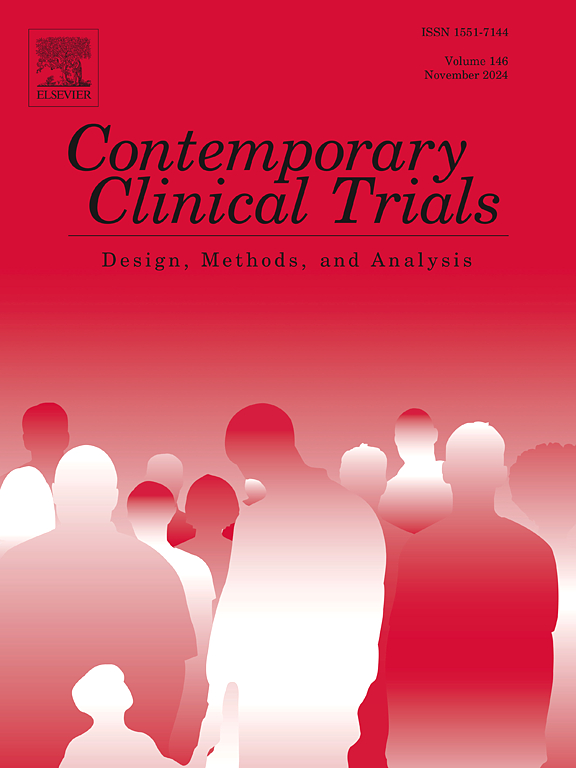评估双吸烟夫妇中涉及伴侣的经济激励戒烟治疗:一项随机对照试验方案。
IF 1.9
3区 医学
Q3 MEDICINE, RESEARCH & EXPERIMENTAL
引用次数: 0
摘要
背景:抽可燃尼古丁香烟并与另一个吸烟者合作的人比其他吸烟者更不容易戒烟。戒烟的财政激励增加了个人的戒断。然而,这些干预措施尚未使用针对夫妇而不是个人的二元方法进行检查。目前的研究将评估双重吸烟夫妇戒烟的双重经济激励干预的两种变体。方法:建立双烟夫妻经济激励治疗的可行性和耐受性,并初步评价其疗效。目前的研究将利用大规模的临床试验来系统地评估两种二元经济激励干预措施在450对双吸烟夫妇中的疗效和改变机制。结果:主要研究结果将是在双吸烟夫妇的目标人群中进行6个月的点流行戒烟(自我报告戒烟7 天+生化验证)。6个月时伴侣禁欲,1、3和12 个月时目标和伴侣禁欲将作为次要结果进行检查。将评估潜在的治疗机制,包括动机和关系过程,以便为未来的干预措施提供信息。讨论:有吸烟伴侣的人在尝试戒烟时,戒烟动机低,成功率低。目前以证据为基础的干预措施针对的是与强烈影响他们的社会网络隔绝的个人。这种方法代表了下一步发展干预措施的关键,有效地利用社会网络成员来产生和维持戒烟。本文章由计算机程序翻译,如有差异,请以英文原文为准。
Evaluating partner-involved financial incentive treatments for smoking cessation in dual-smoker couples: A randomized controlled trial protocol
Background
Individuals who smoke combustible nicotine cigarettes and are partnered with another smoker are less likely to quit smoking than other smokers. Financial incentives for cessation increase individual abstinence. However, these interventions have not been examined using a dyadic approach that targets the couple rather than an individual. The current study will evaluate two variants of a dyadic financial incentive intervention for smoking cessation in dual-smoking couples.
Methods
Feasibility and tolerability of dyadic financial incentive treatments in dual-smoking couples has been established, along with their preliminary efficacy. The current study will utilize a large-scale clinical trial to systematically evaluate the efficacy and mechanisms of change of two variants of dyadic financial incentive interventions among 450 dual-smoking couples.
Results
The primary study outcome will be 6-month point-prevalence abstinence (self-report abstinence for 7 days + biochemical verification) among targets in dual-smoking couples. Partner abstinence at 6-months, and both target and partner abstinence at 1, 3, and 12 months will be examined as secondary outcomes. Potential treatment mechanisms, including motivational and relationship processes will be evaluated to inform future interventions.
Discussion
Individuals with smoking partners experience low motivation to quit and low success rates when they make quit attempts. Current evidence-based interventions target individuals in isolation from their social networks that strongly influence them. This approach represents a critical next step toward developing interventions that effectively capitalize on social network members to produce and sustain smoking cessation.
求助全文
通过发布文献求助,成功后即可免费获取论文全文。
去求助
来源期刊
CiteScore
3.70
自引率
4.50%
发文量
281
审稿时长
44 days
期刊介绍:
Contemporary Clinical Trials is an international peer reviewed journal that publishes manuscripts pertaining to all aspects of clinical trials, including, but not limited to, design, conduct, analysis, regulation and ethics. Manuscripts submitted should appeal to a readership drawn from disciplines including medicine, biostatistics, epidemiology, computer science, management science, behavioural science, pharmaceutical science, and bioethics. Full-length papers and short communications not exceeding 1,500 words, as well as systemic reviews of clinical trials and methodologies will be published. Perspectives/commentaries on current issues and the impact of clinical trials on the practice of medicine and health policy are also welcome.

 求助内容:
求助内容: 应助结果提醒方式:
应助结果提醒方式:


